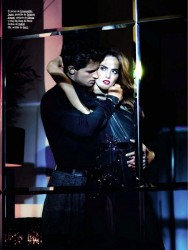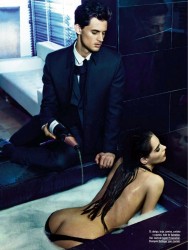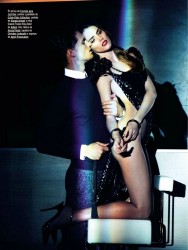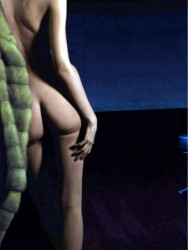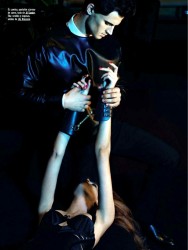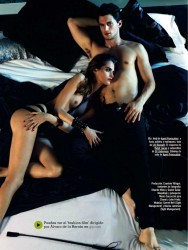Interview: Steve Kriozere and FEMME FATALES
 |
| “Bad Medicine” episode: Director Darin Scott, Actress Christine Donlon, Writer Steve Kriozere |
Steve Kriozere is a writer/producer with an impressive resume that includes work on “NCIS,” “Castle,” and “Femme Fatales.” If you have not gotten a chance to try out “Femme Fatales,” it is a show worthy of your consideration. You can leave any preconceived notions at the door, and start out with “Femme Fatales: The Complete First Season,” which is now available and you can purchase here. You can read a recent review of the show here.
The following is an interview with Steve Kriozere where we discuss what “Femme Fatales” is all about from various points of view. We also talk about “Elvis Van Helsing,” (review here) an offbeat horror graphic novel that Steve co-wrote with Mark A. Altman, who is also a writer/producer involved with, among other projects, “Castle” and the co-creator, with Steve, on “Femme Fatales.” We wrap up with a discussion on the writing process and what lies ahead for “Femme Fatales.”
We begin by discussing the tricky position that this show finds itself in. It’s a show on Cinemax. That carries a unique set of issues. For instance, the concept of “less is more” can be a hard one for the network to grasp. The creators and writers on the show must find ways to deliver the goods, the sexual content, in new and creative ways while also building up a show. Here’s the thing, this is, at its heart, a clever show. There are so many things going right with this show, from its charismatic host, Tanit Phoenix, to its exploration of genres and, well, embrace of geekdom. The show, at the end of the day, retains its potential which, by all rights, should remain forever elusive.
The full interview with Steve Kriozere follows and includes the podcast at the end.
Henry Chamberlain: I have a lot of thoughts about “Femme Fatales.” It has its own audience and it can keep growing. I think the stumbling block for some folks is thinking it’s all about gratuitous sex without ever giving the show a chance.
Steve Kriozere: Cinemax has the wrap. They’re trying to change that image. It’s like a toxic lake and this is the first step in cleaning it up.
HC: As they say, it’s not your dad’s Cinemax anymore.
SK: That’s right.
HC: This is going a bit out on a limb but I think of Lena Dunham, on HBO’s “Girls,” and she is engaging in sex scenes and nudity and it’s legitimate. It moves the story forward. The same can be said for “Femme Fatales.” SK: We knew going in that it would be a challenge doing this type of show. To organically find ways to include that type of content can be a challenge. It is our hope that, when those scenes occur, they don’t bring the narrative to a halt.
 |
| Christine Donlon and Robert LaSardo in “Bad Medicine” |
HC: I wanted to jump to a specific episode, “Bad Medicine,” which you wrote. It’s really well paced. I love that the gang member quotes Jimmy Cagney from “White Heat.” I don’t know if a gang member would really say that but it sounds good coming from Robert LaSardo. Well, it’s a very well paced story.
SK: Thanks. It was the second one we shot. It’s a story taking place in real time, similar to “Speed Date” and “Haunted.” When it’s real time, you want to have things move quickly pacing-wise. HC: I see, of course.
HC: I see, of course. SK: It wasn’t sure if Robert LaSardo would want to work with us as his work tends to be more mainstream. Spoiler alert. He’s in a love scene, a fantasy love scene in “Bad Medicine.” He was happy with it. He said, “Man, I owe you one.” (laughs)
 HC: You’ve got a number of name actors coming on board.
HC: You’ve got a number of name actors coming on board. SK: For Season One, we had actors willing to take a chance on a new show. These are actors we’d worked with before, like Robert LaSardo. We also had Dean Hagland, Charlie O’Connel, Angus Scrimm. By Season Two, the show had made a name for itself and we had actors we hadn’t worked with before: Jeff Fahey, Vivica A. Fox, Robert Picardo. We had Paul Mazursky play a prison warden on our first season. That really means something.
 |
| Paul Mazursky and Kit Willesee in “Behind Locked Doors” |
HC: Yeah, that’s impressive to get Paul Mazursky.
SK: He’s an Academy Award nominated director. I ran into him recently and he talked about how much he enjoyed doing the show.
HC: That’s cool.
SK: Good for him to be on the show. It’s stuff like that that helps to elevate the show.
HC: I wanted to ask you about the comic book that you and Mark A. Altman did a few years back, “Elvis Van Helsing.”
SK: “Elvis Van Helsing” was a TV pilot. What ended up happening is that ABC Family chose at that time to go with “The Middleman.” We’re big fans of Javier Grillo-Marxuach so we were very happy for him. We’re also happy with the reaction to “Elvis Van Helsing.” It was an idea pitched to Larry Young at Ait Planet Lar and he ran with it. Everyone who has read it has enjoyed it.
HC: Wasn’t “The Middleman” originally a graphic novel?
SK: It was a spec TV pilot that became a comic book which became a TV series. Strange but true.
HC: It’s interesting how these things are so interconnected. Getting back to “Femme Fatales,” this second season has seen a full on superhero episode and a full on science fiction episode. Can you talk about the evolution of the show?
SK: We’re pushing the envelope with the show. There’s a full on grindhouse episode, “Hell Has No Furies.” The science fiction episode is “Bad Science,” by the same director as “Bad Medicine.” Mojo, who won an Emmy for his work on “Battlestar Gallatica,” did the special effects for “Bad Science” so we got very high production value. We close out the second season with a two-part comic book episode, “Libra.” This was concieved by Bob Layton who was the artist for Marvel Comics’s “Iron Man” for many years. We feature some of his artwork in “Libra.” We told ourselves if we ever did a superhero episode that we were going to do it right.
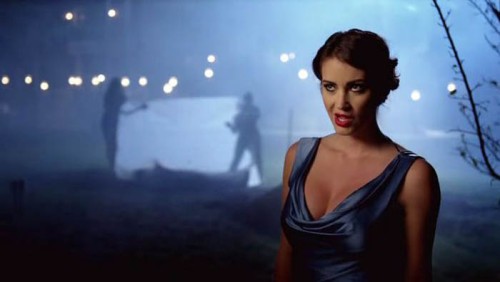 |
| Tanit Phoenix, as Lilith, host of “Femme Fatales” |
SK: Yeah, I believe her first cameo was on “Bad Medicine” where you see her pulling the strings to the other characters. There’s a hint to a bigger story and we hint at that more for the first season’s two-part finale, “Visions.” We wanted to do a whole story about how she was murdered and she is out to exact revenge with the help of the other femme fatales who have been wronged but the network didn’t want to do that.
HC: They weren’t ready to commit to something like that?
SK: Yeah, they just prefer to not go there.
HC: I also love the pop culture references you guys make. For instance, at the end credits to “Girls Gone Dead,” the episode is dedicated to Fawn Leibowitz. (laughs) I’ll let readers who don’t get that to look it up.
SK: I forgot about that one. (laughs) But, yeah, we enjoy sprinkling in references to pop culture, stuff we grew up on. For instance, the character Violet MacReady, from “Bad Medicine,” is named after R.J. MacReady from “The Thing.” So, maybe Violet was spawned from some adventure in Antarctica.
 HC: Okay, I have a silly question.
HC: Okay, I have a silly question. SK: There’s no question too silly for “Femme Fatales.”
HC: What would Rod Serling make of the show? He was ahead of his time so maybe he’d get it.
SK: I don’t think he’d get the sexual content since he’s from another era. We’ve had episodes with twists to them like “The Twilight Zone.” I think he might enjoy the comedy we’ve done. On the old “Twilight Zone,” the comedy didn’t work so well. He might like our comedy episode, “Speed Date.” I’m sure he’d think it was better than the movie they made of “The Twilight Zone.” (laughs)
HC: There you go. (laughs) Well, on that note, I want to thank you for your time. I did have another question. I was curious about your dual role as writer and producer. Do those two roles feed off of each other?
SK: When you see the credits for producers, those are titles for writers. You need to learn how to produce for the show too so you learn both trades. There’s a lot of producing going on for “Femme Fatales.” We come up with a concept and then we have to find ways to produce it all on one spot.
 HC: It’s not so cut and dry where all you do is write?
HC: It’s not so cut and dry where all you do is write?SK: It depends on the show. Sometimes all you will do is work on the scripts and outlines. And you won’t be involved with the casting, or the pre-production, or the editing, or being on set. Every show is different. So, it depends on what you will do.
HC: Well, you can do it all. You have a very impressive resume and you’ve been around for a long time.
SK: Thanks. “Femme Fatales” is the most creative freedom we’ve ever had. To come up with original characters every week is pretty awesome. It’s pretty fun. Whatever we get approved by the network we need to go find and do. So, if they approve a sci-fi episode, we’re like “Oh my God, here we go!”
HC: That’s very cool.
SK: Season Two definitely has a lot of great episodes. We’re really pushing it in terms of creativity and budget. I think people, if they haven’t seen it, will really enjoy it. And it will make a great DVD set when it comes out later this year.
HC: Have you gotten the greenlight for Season Three?
SK: We haven’t heard yet but hopefully soon. We have a lot of ideas and certain characters we’d like to bring back. So, we’ll see.
HC: Very cool. Well, thank you, sir.
SK: You’re welcome.
You can hear the podcast to this interview here: Kriozere
“Femme Fatales” is a new breed of show. Check it out at our friends at Cinemax here.
+++++++++++++++++++++++++++++++++++++++++
Don’t Call Lena Dunham ‘Brave’
Girls creator and star Lena Dunham is debatably the most significant figure currently working in television (itself a medium that is rapidly overtaking film in social relevance), as well as 26 years old, female, and famously inclined to take off her clothes on-camera despite having a frankly fairly normal body type. In Hollywood, where gender politics are stuck somewhere in the mid-twentieth century, like pretty much every other major industry, it is as uncommon for a young woman to occupy positions of power as it is for people who are not super skinny to get naked. This week’s episode of Girls, with its explicit depiction of her character Hannah’s sexual fling with Patrick Wilson, an older man who has invited comparisons to a Ken doll, sparked a vitriolic social-media and critical debate over whether their coupling was believable; in defending her, the pro-Dunham side often used a nonsense superlative that is nearly always reflexively applied when her supporters describe her frequent nudity: brave.
Puke.
Lena Dunham is not a rape victim, she is a writer-actor-director who is exceptionally well compensated both financially and in the artist’s capital of choice — attention — for exploiting her body as an artistic commodity. This is wholly deserved: Dunham is one of the medium’s most gifted artists working at her full potential. However, calling this brave as opposed to a calculated risk — the ideal impact of which is the exact debate that it has caused — is paternalistic, condescending, and intellectually dishonest. Writers are narcissists: They presume that their personal obsessions and neuroses are of deep fascination — or even beneficial — to potentially millions of people. Actors are narcissists: Outside of a musical, there is no breed of human more likely to break into public song. This is not a negative. Narcissism is as essential to the artist’s temperament as competition to the athlete’s; without it driving most of your waking hours, you are, at best, a precocious hobbyist. No one dragged Lena Dunham in front of the camera. As a producer, I will confidently state that no one was ever cast in a major television show against their will regardless of how much people wanted to see their tits. The point is that Lena Dunham the performer is subject to the material provided her by Lena Dunham the writer – both of whom I’m willing to bet enjoyed leaving the Golden Globes with an armload of statues. And her show in the first place is a kind of dramatically reenacted LiveJournal; she has admitted to keeping a record of incidents that occur in her own life to be mined potentially, if it weren’t obvious enough already. As she should. Oversharing is the artist’s job, and the applause they receive for doing so is what, pre-success, fuels them to connect with audiences. The Salinger road is available to all, and even he only took it after ensuring everyone would be talking about it.
It is not the dictionary definition of “brave” that is so objectionable, but rather the fact that its connotation through current usage in the news media has made it a treacly Tupperware fart of a word that calls to mind an initial condition of contrived weakness and sympathy, such as overcoming a stutter. And often Dunham depicts herself as a sort of underdog who has succeeded in spite of her eccentricities and hyperactive neuroses (which in actuality fails to distinguish her from the entire upper echelon of Hollywood); her public persona, humble and little-old-me-ish, is not unlike Tina Fey’s, whom Dunham humbly and little-old-me-ishly thanked at the Globes for helping her get through middle school — this after beating Fey for Best Actress. Anything said into a microphone is an act of marketing that bears as much or little resemblance to reality as benefits the message. This is not to necessarily call this public persona a falsehood, but a selectivetruthhood; projecting the facets of your personality that are charmingly self-effacing is effective strategy, but the emphasis here is on facets. Lena Dunham is not weak. Lena Dunham will cut your throat in your sleep. In addition to cultivating (a) a unique and resonant voice as a writer, and (b) the political skills necessary to manage a set as director (both accomplishments, irrespective of age or gender), she has made a series of uncannily shrewd business decisions that have made her a star and the de facto mouthpiece of the hipster gestalt. And her remarkable pan-demographic appeal is also worth noting; I know a number of men — and count myself among them — who consider her stronger at writing for male characters (authorial intent perhaps subject to debate in one’s surpassing desire to see Jessa pushed in front of the G train).
Moving to the subject of her haters, in the diluvian backlash against Dunham’s prosperity/right to exist — which resembles nothing more than a hysterical mass colonic of misogyny — there is one argument that deserves a moment’s consideration: Dunham’s background of privilege. To this I would counter (a) I’m confident that an informal poll of film and television professionals would yield nearly complete ignorance of her artist parents or their work (I will raise my own hand as one of them), and (b) let me refer you to the untold thousands of similarly advantaged progeny whose film/television/book deal has yet to materialize because they didn’t work as hard. Crying nepotism is roughly as productive as protesting the rotation of the earth, and to be honest, in an industry as merciless, competitive, and surprisingly meritocratic as entertainment, anyone who is resistant to capitalizing on whatever advantages they possess going in is a fool of the first rank. Market success, let alone your artistic legacy, are not determined by how much your own life happens to resemble a Horatio Alger story. Not to mention it’s a minor miracle in the first place an Oberlin graduate from the New York art scene has made something watchable.
So I don’t believe “brave” is misapplied based on the social prestige of her upbringing, nor another case I have heard made within industry circles: that she has only reached her current position through the patronage of Judd Apatow. Not only is this not an accusation you hear leveled at any number of Apatow’s male protégés, it suggests a willful misunderstanding of the Hollywood apparatus. When Dunham was perceived as a hot commodity coming off of Tiny Furniture, she would necessarily have been flooded with professional opportunity, including, presumably, bigger and safer bets from major movie studios. HBO was a far greater risk than she is being given credit for; as the most respected brand in premium television they are both notoriously overbought — last I heard, they had something like 40 projects in development — and fickle: see The Corrections and an elephant’s graveyard of shows with A-list talent that never made it past the pilot stage. So of all potential choices given, Dunham made the most interesting one that best aligned with her talents, and it paid off.
The film The Departed opens with Jack Nicholson saying, “I don’t want to be a product of my environment; I want my environment to be a product of me.” Dunham has achieved this and deserves proper respect for it. Is she “brave” for casting her smart, attractive Brooklyn friends in a showcase of how poignant and interesting her Brooklyn coming-of-age was? Like any successful art, this could be more accurately described as unusually lucrative therapy. Is she “brave” for her physical immodesty? She herself publicly vacillates between saying she is “not stressed” about nudity to calling it a “compulsion”; not having a dog in the fight, I would simply call it opportunistic, in the same way that all art is a product of shameless opportunism that deserves to be applauded. The word I would submit as a replacement is baller; this is a woman who has risen through a masculine power hierarchy to become one of the most important culture-makers of the 21st century without compromising her artistic identity, and is fucking a rock star, this is more or less as baller as it gets. In the end this is, of course, a semantics argument. But in the end, so is life.
As to the diversity question, the heterogeneity of the young creative class is certainly a worthy social problem, but not one that will be solved by making a show about Greenpoint hipsters who more closely resemble the cover of a seventh-grade health book.
Brian McGreevy is the author of Hemlock Grove, as well as executive producer of the forthcoming Netflix original series of the same name.
* The way McGreevy casually dismissed Lena's perceived 'bravery' (constantly bestowed particularly by female-centric writers. Wonder how they'd reacted if it was Kate Upton?) in going nude and he's right about it too imho, I expect Hemlock Grove to be chock-full of nudity from main cast besides Penelope Mitchell. I want Freya Tingley to give Lili Simmons a run for her money for the title of teen nudecomer of the year. On-camera nudity isn't about being brave. It's liberating.
IFFR 2013 Review: LONGING FOR THE RAIN Gives An Unflinching Look At Sexual Desire
+++++++++++++++++++++++++++++++++++++++++'Homeland' Daughter Morgan Saylor Signs With UTA
 The actress plays Dana Brody on the acclaimed Showtime drama.
The actress plays Dana Brody on the acclaimed Showtime drama.
Morgan Saylor, who plays the eldest child of POW-turned-terrorist Nicholas Brody on Showtime’s Homeland, has signed with UTA.
The 18-year-old actress has been on the drama since its premiere in 2011. She also appeared in 2009’s Cirque du Freak: The Vampire’s Assistant and next will be seen in the indie Jamie Marks Is Dead, which is set to begin production at the end of this month.
Saylor continues to be repped by Atlanta-based J Pervis Talent Agency, The Osbrink Agency, Management 360 and attorney Steve Warren of Hansen Jacobson.
* foul-mouthed Morgan Saylor in a R-rated flick. Maybe I'm flat wrong here but I believe she'll play the role of 'Gracie'. The love scene from the book is likely to be included in the movie as well. Perhaps Shailene Woodley type of nudity from The Spectacular Now. On related matter, Ms. Saylor is also on schedule to show her teenie tits in season 3 of Homeland. I'll try to update as often as possible on that in coming months. The 18-year-old actress has been on the drama since its premiere in 2011. She also appeared in 2009’s Cirque du Freak: The Vampire’s Assistant and next will be seen in the indie Jamie Marks Is Dead, which is set to begin production at the end of this month.
Saylor continues to be repped by Atlanta-based J Pervis Talent Agency, The Osbrink Agency, Management 360 and attorney Steve Warren of Hansen Jacobson.
+++++++++++++++++++++++++++++++++++++++++
25-years old model Marina Jamieson : Sergi Pons [GQ España febrero]2013
Garrett Neff goes for the "full 50" in this Shades of etc and so on themed editorial in the February 2013 issue of GQ España. Titled "Señor Grey," the story by photographer Sergi Pons opens innocently enough with Garrett's Mr. Grey peering through venetian blinds, but rapidly gathers paces with a shower of the bubbly poured over the bare derrier of model Marina Jamieson's (Sight) Anastasia Steele.
Here is a flip book video i did of outakes from my book, FLIP.. published by Gravure editions.. thank you to elisa, paz, poppy and anouck... and megan ross for the clothes and iker for editing this together.. special thank you to Jamie and Alison from The Kills for letting me put "Baby Says" behind it all.. perfect fit..
True Blood: When Good Shows Go Bad
By MJ Snow

WARNING: This article contains spoilers for Season 1 – Season 5 of True Blood. It also contains some controversial opinions about the much-beloved vampire franchise. Leave your comments and hate-mail below in the comments.
How could something so good go so terribly wrong? What used to be a campy, entertaining look into the lives and loves of the residents of Bon Temps has turned into a groan fest of epic proportions. Over the course of the it’s five season run, True Blood has gone from a show we couldn’t wait to watch, to the show we love to hate. There are some fans who insist that the series went south purely due to creator Alan Ball’s insistence on straying farther and farther from the plots of Charlaine Harris’s Southern Vampire novels. I would argue that there is more to it than that. In the world of book to television adaptation, it’s understood that some changes must be made to the plot lines in order to meet budgetary restrictions or to whittle a story down to fit into a forty five to sixty minute time slot. What we’re looking at with True Blood is not the fact that changes were made, but that there is little rhyme or reason to the changes. Most of them are just plain silly. We add to that the addition, or manipulation, of characters that, to put it bluntly, are just plain awful. Likeable characters become whiny, obnoxious and frustrating to watch. Original characters are silly at best, and practically unwatchable at worst. Too many storylines make the show seem scattered and unfocused. Let’s break it down by season and take a look at how Alan Ball and company did bad things with True Blood.
Laissez les Bons Temps Rouler
Season 1 rolled out strong as we were introduced to Sookie’s world. The cast of characters was made up of quirky humans and (mostly) sexy vamps, Sookie’s telepathy was an interesting twist and Bill Compton simply oozed Southern charm. Sex, drugs, murder and more sex completed a fairly well rounded first season. Even fans of the book series seemed to enjoy HBO’s adaptation of Charlaine Harris’s book series, despite the fact that Alan Ball had put his own spin onto the television series. Things were looking good, what could possibly go wrong?Maenad Mayhem
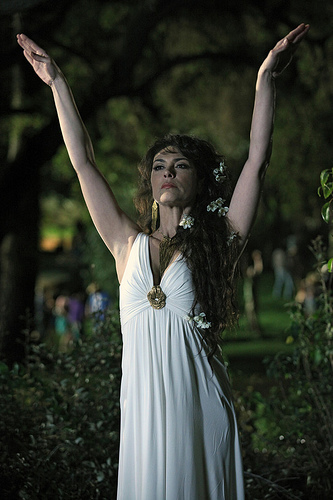 As Season 2 began, fans of the show had high expectations. Perhaps this one is a slow starter, we thought. Maybe a slow buildup will result in a huge payoff. Sadly, fans received no return on investment for their patience and time. Instead we got a Maenad. For those familiar with Greek Mythology, the Maenad idea might sound intriguing. In reality, what True Blood gave us was meat sculptures and unattractive rednecks indulging in orgies. Maryann (Michelle Forbes) has the honor of heading off our list of ‘The Worst True Blood Characters (TWTBC) of All Time’.
As Season 2 began, fans of the show had high expectations. Perhaps this one is a slow starter, we thought. Maybe a slow buildup will result in a huge payoff. Sadly, fans received no return on investment for their patience and time. Instead we got a Maenad. For those familiar with Greek Mythology, the Maenad idea might sound intriguing. In reality, what True Blood gave us was meat sculptures and unattractive rednecks indulging in orgies. Maryann (Michelle Forbes) has the honor of heading off our list of ‘The Worst True Blood Characters (TWTBC) of All Time’.We also met Lorena (Mariana Klaveno), Bill’s vampire maker. Bad writing and Klaveno’s overacting combine to land Lorena in the number two spot on the TWTBC list.
Bring on the Fellowship of the Sun, a Dallas based anti-vampire hate group run by the Reverend Steve Newlin (Michael McMillian) and his stepford-esque wife, Sarah (Anna Camp). The Newlins also run the Light of Day Leadership Conference, which trains new members of the congregation in both Bible study, and the eradication of vampires. Jason’s involvement with the Newlins was snooze worthy, but sadly, it was also probably the least offensive storyline of the season.
Supes on Parade
Several new storylines debuted in the third season, most of which were barely watchable. We were, however, blessed with the addition of Russell Edgington (Denis O’Hare), King of Mississippi, the first of two bright spots in Season 3. Edgington’s storyline is dismal, but O’Hare delivered his lines so well, we nearly forgot how badly written they were.During this season Tara found a new love interest, the mysterious vampire Franklin Mott (James Frain). Franklin was quite possibly the most brilliantly entertaining character True Blood has ever seen, so of course we saw him killed off before the season is finished. Alan Ball, you are such a tease!
Bill went missing, Sookie was frantic and nobody really cared, not even those of us watching the show. I can’t help but wonder, if Bill had never been found, the show might possibly be in a better place today.
Lafayette finds love in Season 3, and it just so happens that his new beau, Jesus (Kevin Alejandro) somehow awakens Lala’s ability to communicate with spirits. What are the odds of that?
The much anticipated arrival of werewolves, specifically, Alcide Herveaux (Joe Manganiello), fell flat when the weres turned out to have no redeeming qualities whatsoever.
Competing for the worst in Season 3, however, were Sam’s dog fighting, shape shifting, trailer trash family and Jason’s involvement with werepanther Crystal and her creepy, inbred family. It’s True Blood, Deliverance-style.
The Worst Witch
If we thought that Season 3 was rough, Season 4 brought the show to an all-time low. Truly, everything in this season was so bad, that it’s difficult to narrow it down to the season’s biggest mistakes.Sookie learned about her fairy family ties, taking a long vacation to fairyland and coming back with a moderately better handle on her super powers. The fairies were portrayed as obnoxious, bordering on ridiculous. Ball didn’t even have the courtesy to cast the faeries as attractive enough to distract us from their pathetic plot.
Eric Northman had a run in with a local coven of witches, resulting in the complete loss of his memory. Book fans who’d been looking forward to seeing Mr. Northman return to his Viking mindset were disappointed to find his character had become flat and boring. Eric seemed to not only lose his memory, but his manhood as well, spending much of the season hiding in Sookie’s closet. My intention isn’t to compare the books to the HBO series here, but that storyline came from one of the most popular books in the series and HBO really dropped the ball there.
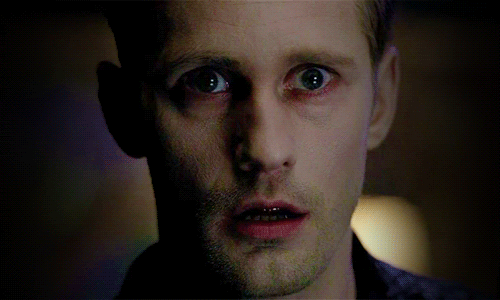
Jesus, a Brujo, or Mexican Shaman, senses Lafayette’s spiritual potential and encourages the reluctant medium to become involved with the Bon Temps witches coven. Marnie (Fiona Shaw), the coven’s leader, was perhaps the worst joke that Alan Ball and friends have ever played on the fans of the series. The casting of Fiona Shaw, an accomplished Irish actress with an impressive repertoire, raised our hopes high. Instead of raising the bar, however, Shaw sank to the depths, skyrocketing Marnie to top the Worst True Blood Characters of All time. Possessions abounded as both Lafayette and Marnie became the hosts to vengeful spirits. Ah Lala, how we used to love you! How sad it was to find ourselves cringing with every flutter of your lovely lashes!
Jason’s storyline also hit rock bottom in Season 4. Kidnapped by Crystal’s family he divides his time between being locked in a freezer and tied to a bed, used for breeding with the werepanther females. This, my friends, was the season that I nearly stopped watching True Blood.
Bilith
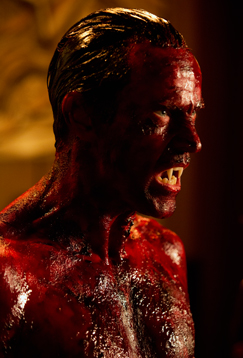 After having invested so much time in True Blood, I decided to give it one more go. This show, I thought, could not possibly be any worse. Turns out I was wrong.
After having invested so much time in True Blood, I decided to give it one more go. This show, I thought, could not possibly be any worse. Turns out I was wrong.Sookie and Lafayette begin the season dealing with the aftermath of the deaths of Tara and Debbie Pelt. Regrettably, before we even had a chance to begin to celebrate Tara’s departure from the series, Pam showed up and turned her into a vampire. The collective groan from the watchers of True Blood was heard round the world.
Jason and Andy Bellefleur stumbled upon the fairie’s secret burlesque discotheque. Andy also finds himself involved with the fairie, Maurella (Kristina Anapau), leading up to Andy being forced to help deliver her quintuplet babies, which she then leaves behind in his care. The birthing scene was about as silly as it gets. This scene was so foolish, I actually felt insulted as a viewer. The truly sad part about this is that the fairies could have been a really interesting diversion, if they’d only been able to leave the cheese behind and show them as clever and dangerous, a force to be reckoned with.
Terry Bellefleur and the Smoke Monster. Moving on …
The Vampire Authority story line was another train wreck. Rather than showing the Authority as a force to be reckoned with, instead they come across as a group of bumbling fools. Russell Edgington returns, but unfortunately, even Denis O’Hare can’t save us from the misery of this season. Russell takes over the Authority, persuading the lesser members to drink the blood of Lilith, who was, according to vampire lore, the first vampire. Lilith’s blood causes them to get high and during their trip, Lilith herself appears to them, materializing out of a puddle of blood, B-movie style, naked and covered in blood. Bill comes to believe that Lilith wants him to lead the vamps of the world, so we finish the season with Bill double crossing everyone, drinking the remainder of the Lilith blood and dying the true death. Bill then also rose, reborn, from a puddle of blood. This was our season finale and I, personally, was thankful to see Season 5 come to a close.Wishing and Hoping
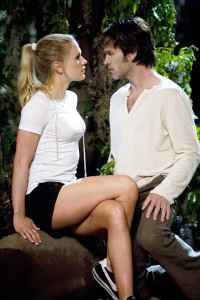 I’ve barely scratched the surface here; there are simply too many bad moments to list. Looking back over the series, it’s clear to see that the bad writing, weak plot elements have gotten worse as the seasons have progressed. It makes one wonder if the writing team is even showing up for work anymore. Is there a possibility that Season 6 might be able to redeem this dying series?
I’ve barely scratched the surface here; there are simply too many bad moments to list. Looking back over the series, it’s clear to see that the bad writing, weak plot elements have gotten worse as the seasons have progressed. It makes one wonder if the writing team is even showing up for work anymore. Is there a possibility that Season 6 might be able to redeem this dying series?Call me optimistic, but now that Alan Ball has stepped aside and taken a lesser role, I believe that there could be a glimmer of hope for the citizens of Bon Temps. Tone down the cheese factor, cut back on the minor characters pointless storylines and bring the focus back to the core characters. I’d love nothing more than to see the show come full circle and return to the sexy, campy fun of Season 1. We can only wait and wish and hope, and in the meantime, we can continue to love to hate the True Blood.
MJ Snow is a Canine and avian behavior specialist by day; a role player, blogger and writer by night. A long time George RR Martin fangirl and Game of Thrones Addict, MJ spends way too much time in Westeros. MJ is the founder ofThe Snow Keep, a short story and fan-ficiton blog and The Brothers Clegane, a Sandor and Gregor Clegane tribute blog, she also co-curates several other Game of Thrones themed blogs.
+++++++++++++++++++++++++++++++++++++++++
Why sex onstage rarely works
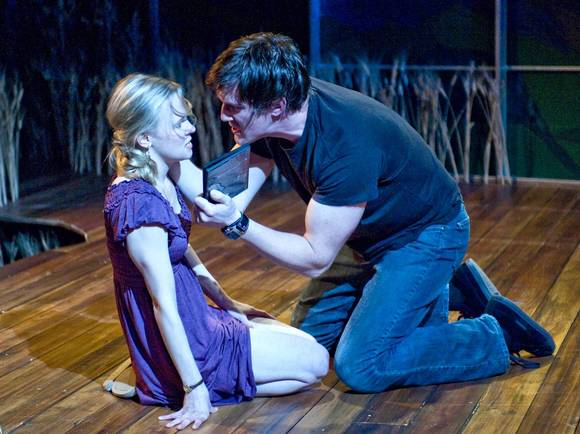 |
| "Hesperia" by Randall Coburn at Writers' Theatre. ( / February 3, 2012) |
Chris Jones Theater critic
February 16, 2013
February 16, 2013
"Chris Jones," the knowing tweet declared, as if triumphantly outing a prude, "does not like plays with a lot of sex."
Now people ascribe inaccurate predispositions to critics all the time. Ignoring them is part of the job. But the tweet cited sufficient relatively recent evidence to give one pause. Alongside "Teddy Ferrara," there was "Dirty," an Andrew Hinderaker play at the Gift Theatre about the pornography industry, which required one of its actresses to make an erotic video, and there was "Hesperia," a Randall Colburn drama about a former porn star who becomes a Christian but retains certain interests of his former profession. That last show, which premiered at Writers' Theatre, required a couple of its stars, playing a former porn star and a verbose virgin, to make loud, frantic love, right there on the cold, hard floor in Glencoe.
I was no rabid fan of any of those three plays — mostly for reasons other than the sex, but it's true that I also thought that the sex did not work. Sex onstage rarely does.
Sex on screen is something else entirely. Consider "The Sessions," the remarkable Ben Lewin independent movie about the late Mark O'Brien, a severely disabled polio survivor who lived most of his life in an iron lung, but who decided, at 38, that he no longer wanted to be a virgin. This beautiful film, notable for its abundance of good-hearted, well-meaning characters, is greatly preoccupied with the mechanics of sex.
The O'Brien character, played by John Hawkes, hires a sex surrogate, played by Helen Hunt, whose extraordinary performance deserves an Academy Award next week. One finds oneself cheering on O'Brien as he navigates tricky angles, his need for oxygen and his struggles with premature excitement. I was only just removed from shouting something like "turn a bit to the right" at the screen. There are bodily parts, mostly owned by Hunt, swinging, squeezing and colliding in "The Sessions," but you're too engrossed in the main narrative action to really notice. These are near-perfect sex scenes.
Last week's episode of the fine HBO drama "Girls," intriguingly titled "One Man's Trash," also had a lot of sex. The apparent inability of the show's 26-year-old star and creator, Lena Dunham, to keep her clothes on for very long has attracted much notice among the Twitterati, of course, but Dunham and her curves have managed to upend so many conventional notions about cable TV sex that these scenes become both immersive and subversive.
No wonder Dunham is figuring out how to spend her reported multimillion-dollar advance from Random House for her debut collection of essays. She is a master of the sex scene used as a portal for mass-identification.
But her use of frequent sex in the show is not just realistic, it's also shrewdly aspirational: as when her character Hannah makes love to a much-older man, played by actor Patrick Wilson, inarguably one of the sexier men alive. One could only imagine what was going on at that moment in the heads of Dunham's audience. As sex scenes go, here was another corker of complexity.
So why can't the stage do this?
Part of the problem, of course, is that one views "Girls" or "The Sessions" in the dark — or, at least, in the kind of isolation that the theater does not easily afford. On film, your eye sees the action only from angles carefully selected. The sex in "Girls" has the laudable aura of frank spontaneity, but it's an illusion. One sees not the strings. Onstage, especially in the small venues common in Chicago, your inevitably broader view of the action is frequently framed by other audience members. At "Teddy Ferrara" last week, I watched the sex scenes with a squirming high-school-age girl in one part of my field of vision, and a tough-to-read senior gentleman in another. One cannot help but watch them watch what you're watching. "What are they thinking?" you think, which pulls you out of the scene.
Then there's the matter of the actors. Back in 2003, John Istel wrote a savvy article in American Theatre magazine calling for an end to onstage nudity, not on moralistic grounds but because, he argued, "not only is it distracting, it's anti-theatrical. It's the death of artifice."
"Most often," Istel went on to say, "it's just plain embarrassing, both for audience and performers."
Well, not always. And sometimes, embarrassment is a legitimate artistic goal. But regardless of the nudity question, it sure is exceedingly difficult to watch a sex scene without thinking such questions as "Are they really doing that?" or, yet more distractingly, "Are they really going to do that?" Then there's "How does that actor feel about doing that?" or, yet more distractingly, "Were they somehow talked into doing that against their better judgment?" Only rarely does the truth of a scene survive.
Any kind of absolutism does not serve the arts. There can be good sex in theater, just as there can be good sex everywhere else. But it helps when there is some visual distance to frame the experience; when you don't have other audience members as a backdrop; and when the sex session really, truly has something radically distinctive to say.
+++++++++++++++++++++++++++++++++++++++++
Broadcast promo for new series on Directv.
+++++++++++++++++++++++++++++++++++++++++
Trishii - Backpacker
from striplvTVBrianne Chanel Cox - Dirty Little Blonde
Capri Anderson - Angel on my Shoulder
Cathy Zukimoto - Getting Wet
Comedian Cathy Zukimoto behind the scenes at her Strip Las Vegas Magazine photo shoot getting wet.More here
+++++++++++++++++++++++++++++++++++++++++
‘Magic City’s’ Dominik García-Lorido Added To ‘Heat’.

Dominik García-Lorido will be starring opposite Jason Statham in the upcoming Heat. The Magic City actress will play the female lead role of Holly in the Simon West-directed and William Goldman penned film. Her character is the ex-girlfriend of Statham’s Nick Escalante who turns to the good-hearted Las Vegas enforcer for help when she is violently beaten. The movie starts filming in New Orleans and Vegas in April. Garcia-Lorido is repped by Paradigm, McKeon-Myones Management and Underground.
* remake of crappy Burt Reynolds vehicle best remembered for Burt's physical altercation with the director. Goldman revised the script and Statham makes his debut as a producer.
nudity dodger Michaela McManus (Holly audition)
click on her name and check out Michaela auditioning for the role of Lagertha (The Vikings)-Scene 1 and 2. Noted couple of things:
[1] There is going to be a love scene but PG-13 type of nudity?
[2] hilarious voice modulation and face expression in Scene 1.
+++++++++++++++++++++++++++++++++++++++++
Back in October Esquire magazine made official what everyone knows already – that Mila Kunis is the sexiest woman alive. When I asked her about this she laughed - partially at how I asked the question but mostly at the whole charade. Turns out what makes a woman truly sexy is humility and laughter. That and perfect slavic features!
Zooey Deschanel for Allure
Rooney Mara for Allure
+++++++++++++++++++++++++++++++++++++++++
International model Veena Sitram-Booth stars in this charming film 'Sexy on the Inside' that showcases the Mariesa Mae Colette Classic range.
Go to Mariesa Mae to see more of the Mariesa Mae Lingerie collection.+++++++++++++++++++++++++++++++++++++++++
You have read this article Dominik García-Lorido /
Hemlock Grove /
Morgan Saylor /
True Blood
with the title stars, sex and nudity buzz : 02/16/2013. You can bookmark this page URL http://duk78.blogspot.com/2013/02/stars-sex-and-nudity-buzz-02162013.html. Thanks!






